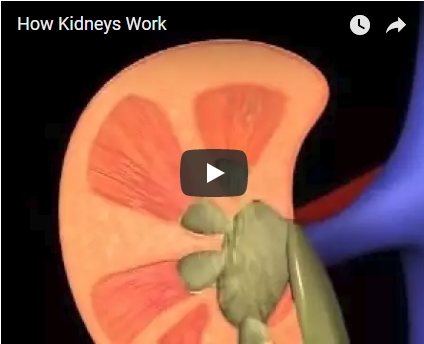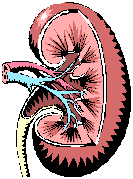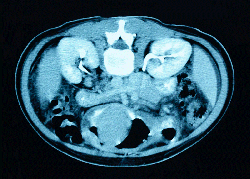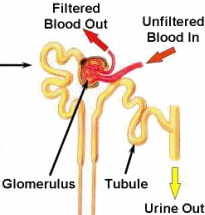Kidney Dialysis Information Centre
So what do your kidneys do?
Your kidneys are used to clean your blood. They remove soluble waste products, minerals and excess fluids from the blood, which are transferred to the bladder and expelled from the body as urine. They maintain a stable balance of salts, ions and water in the body. Your kidneys also help control your blood pressure, via an enzyme called renin, which affects the amount of salts (minerals, including calcium and phosphates) in your blood.
Calcium and phosphate levels are controlled by calcitriol, and problems with this can affect the health of your bones, as explained on this separate page. Your kidneys control the pH of your blood (how acidic it is) and, by secreting the hormone erythropoietin, they can stimulate the production of red blood cells (the body's oxygen transporters) in bone marrow. Kidney failure will affect the production of red blood cells, leading to anemia, and we have a page which explains this in more detail.
How the kidneys clean your blood
Blood continuously passes through the kidneys, at a rate of around a litre per minute, via the renal artery. This quite substantial flow represents about 20% of your heart's output and is responsible for the dark red colour of kidneys. Inside your kidneys, the blood is passed through filters called the glomeruli (around a million of them!). These filters in turn connect to the tubules and the nephrons. Most of the filtrate is re-absorbed, leaving behind the waste products which are passed into the urine and to the bladder, via the ureter. Filtered blood is returned to the heart via the renal vein.
The glomeruli are a small cluster of tiny blood vessels inside a small
bag called the Bowman Capsule (about the size of a pinhead!) When the blood
passes through the blood vessels, some of the fluid is forced through the
blood vessels' walls into the bag, taking with it the nitrogenous wastes
(small protiens, urea and amino acids), salt and glucose. This fluid is
drained away via the bag to the nephron where 99% of the excess water is
reabsorbed back into the body, thus concentrating what's left into urine,
which is passed via the ureter to the bladder.
We have a separate page on glomerulonephritis,
a disease affecting the glomeruli.
You can see several useful videos on kidney function, listed after the first one plays.
Where are the kidneys?
Most people have two kidneys, although some people are born with only one (which enlarges over time to cope with the increased work load). If you have only one kidney, it is still capable of cleaning your blood properly. The kidneys are found under the rib cage, one on each side of the spine, to the back of the abdomen, close to where you elbows reach. (See the MRI scan above, with the kidneys top left and top right.) The one on the right is below the liver. They are bean-shaped, dark red, and measure around 5 - 6 inches (10 - 14 cm) in length, are about 2 inches (5 cm) across and about 1 inch (3 cm) thick. Fold your fingers into the palm of your hand, and your kidneys are about the same size as the folded fingers. Your kidneys weigh about 150 g each.



